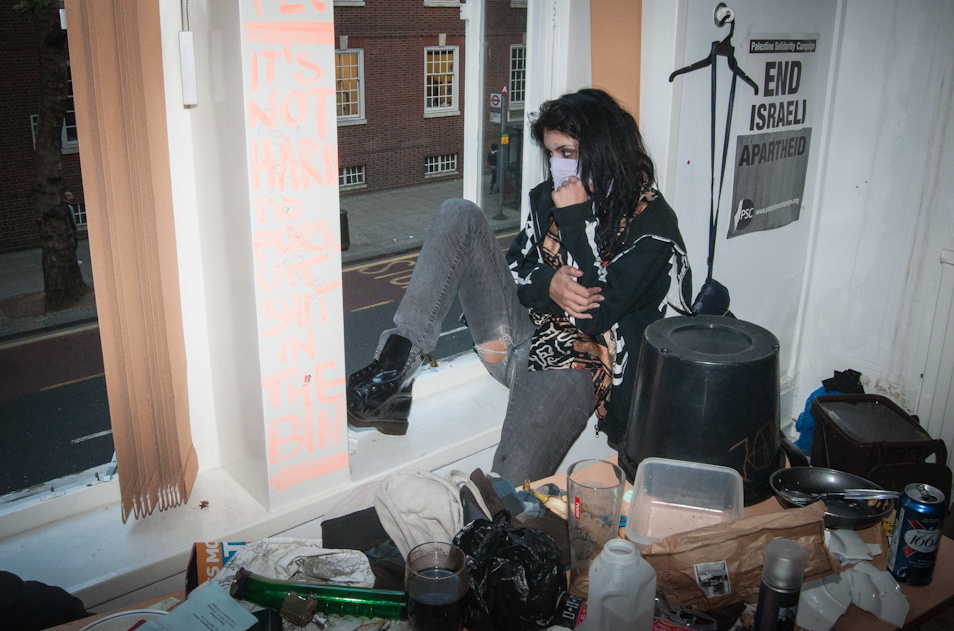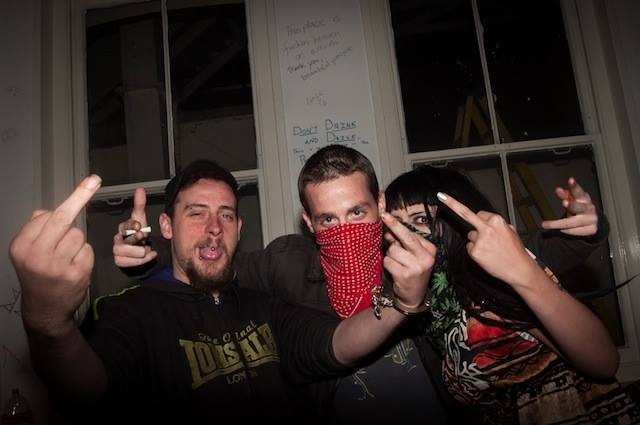(Top photo: Squatters prepare for the police eviction squad at a property in Chancery Lane, London, September 2012. Photo: Jake Lewis)
There was a moment after the Second World War when The Daily Mail considered squatting – the occupation of property without the owner’s consent – to be an act of patriotism. The war had produced a glut of homeless families and veterans without access to social housing. Many decided to house themselves, occupying empty properties throughout the country, especially across the south coast and London. Although the government clamped down on the phenomenon, the Communist Party and the Women’s Voluntary Service helped organise it. By 1946 there were almost 40,000 people squatting in England and Wales, in everywhere from luxury flats in Kensington to holiday homes in Brighton. The press looked on sympathetically.
Videos by VICE
The next wave of squatting in London was in the 1960s and 70s. A new generation of radicals seized empty council properties that the Greater London Council had left to rot. This time the squatters were more political, but the GLC generally tolerated the practice and even licensed a few squats. Today, however, London is not a welcoming place for those who make their homes on someone else’s land. Property rights have only sharpened during the housing crisis; the last government criminalised squatting in 2012.
This is one of the narrative threads in Alexander Vasudevan’s The Autonomous City, which presents a global tapestry of squatting. Vasudevan documents the efforts of squatters from Vancouver to Milan, uncovering a “hidden history” of political struggle. As with any good cultural history, the object of inquiry becomes a cipher for the social forces that run through it. The Autonomous City is as much a story of Italian workerism in the 1970s or settler colonialism in Canada as it is an analysis of the way squatting politicises the domestic sphere, giving us a radically new relationship to the spaces we call home.

VICE: Hi Alex. Squatting is no longer considered patriotic or even acceptable in the UK as it was, briefly, in the mid 20th century. What has changed – has the commodification of housing played a role?
Alexander Vasudevan: Absolutely. In recent decades, we have witnessed what some academics have described as the “neoliberalisation of capitalism”. What this has meant in practical terms is that the recent problems of financial capitalism have been displaced onto the poor while the state has withdrawn or privatised services and placed a premium on exclusive property rights. The very idea that “there is no alternative” has been hard-wired into the fabric of contemporary urbanisation.
What effect has the 2008 economic crisis had on squatting?
One consequence is that it’s pushed people into insecure situations around meeting their basic housing needs. The sociologists David Madden and Peter Marcuse have written a book called In Defence of Housing, where they talk about “residential alienation”. It refers, in part, to the overwhelming sense of precariousness around the ability to house yourself that has become a major horizon of experience for people living in cities. You see it in London, New York and elsewhere.
In terms of squatting, this has meant that people are willing to explore alternatives that five or ten years ago they weren’t willing to countenance. With the Occupy Movement – or, for that matter, the 15-M movement in Spain – the idea of “occupying space” came into sharper focus as well. So you saw movements gaining publicity, especially in southern Europe, such as the PAH (Plataforma de Afectados por la Hipoteca) in Spain. The PAH is a grassroots movement organised to protect the rights of citizens who are facing eviction from their homes. The work of the PAH focuses on eviction resistance, the settling of mortgages as well as the transformation of vacant housing held by financial institutions into sustainable affordable social housing. Squatting is one of the tactics they adopt. We haven’t seen something on the same scale in the UK partly, I think, because repression and criminalisation have played a role in dampening those practices.
WATCH: Squat the Rich
How did you interpret the last government’s criminalisation of squatting?
The argument that was being made at the time is that we were seeing an increasing number of homeowners being affected by squatters – being displaced from their homes. That was the impetus for criminalising squatting in residential properties. But a lot of the evidence for this was anecdotal. My sense was that the legislation was anticipatory as much as it was geared to cracking down on what was actually happening. It was about trying to foreclose the possibility of any alternative way of housing oneself – especially in London and the south-east where there are thousands of empty properties. Just as the housing crisis was beginning to pick up you have this new law, and I don’t think that was incidental.
Your book makes it clear that there are as many different types of squat as there are political demands: pre-figurative, which tries to create a microcosm of a new society within its walls; practical, which simply tries to house people; symbolic or playful, where hippies had a lot of fun. What’s the most effective type?
I don’t think there is any single model. I am reminded of a quote at the beginning of the chapter on Copenhagen: “The neighbours are our best barricades.” Often the squats that were most successful were the ones embedded in local communities or those that were successful in forging connections with their neighbours or, in some cases, local government. In Italy, people often had an affinity with squatted social centres be it in Bologna, Milan, Naples, Rome or Turin. Some of these spaces have been legalised and they remain deeply embedded within the social life of local neighbourhoods.
What also came out during research for the book was how intense these spaces often are: the agreements, debates and solidarities, but also the micro-aggressions and petty forms of violence that shaped and shape squats. After all, people did live with each other over long periods of time and those struggles are intense. That meant joy and excitement, but equally disappointment, failure and anger. I found that it was often emotional labour, if you like, that held these places together.
Emotions are key, especially the crushing disappointment of creating a new world, only to end up reproducing the hierarchies from the old one.
You see it in the Amsterdam scene in the 80s and 90s. There was considerable acrimony and violence. Things no longer worked because people had different commitments to what they saw squatting to be. Often the question of what their relationship to the state would come up – do we negotiate or not? Are we selling out?
I am also reminded of a horrifying case in Hamburg in the 1980s on Hafenstraße, where a community of squatters was confronted with dealing with a serious case of sexual assault committed by three squatters. It had a ripple effect on the wider scene and reminds us that ongoing debates about “safe spaces” have a long history. These spaces were often unsafe. For many women and children, in particular, squats could be quite precarious places to live – this is part of the backstory to a lot of these conversations around safe spaces and the efforts to create and sustain them that we have today – and why they are so important.
“Squatting often conferred a sense of edginess to neighbourhoods, which then gets branded and sold onto a generation of people who have the money to move into them.”
I was walking along Regent’s Canal recently and noticed that every last space – even the boats – had been converted into pitiable “live/work spaces”. Is this the bastardised legacy of squatting?
In one sense, we need to acknowledge that squatting has in some cases been a victim of its own modest success – that the creative and experimental edge has been co-opted and monetised. Squatting often conferred a sense of edginess to neighbourhoods, which then gets branded and sold onto a generation of people who have the money to move into them.
But you also see the enduring possibilities of squatting. Take Spain, for example. The Mayor of Barcelona, Ada Colua, came out of an activist housing tradition, and she has been trying to alleviate the most egregious issues around housing insecurity in Barcelona, like clamping down on aspects of AirBnB and trying to pass laws around housing speculation.
There was a recent report by the UN special rapporteur, Leilani Farha, on housing which pointed out that housing financialisation – treating housing as a commodity – is de-humanising and that housing is no longer people-driven but shaped by the predations of the market. She makes some interesting policy prescriptions. In London, of course, we’ve had a lot of copping out in this respect. The mayor made some promises on affordable housing, which he’s now beginning to scale back – we need to hold people to the promises they made and have a serious conversation about alternatives.
You write at the end of the book that the forced migration crisis has given squatting a new role in southern Europe.
There are migrant solidarity networks emerging across Greece, Italy and Spain, some of which are organised around housing provision. There are a number of refugee squats in Athens and elsewhere, for example. They operate as a parallel geography of care, alongside official channels and spaces. They provide an alternative infrastructure, where it doesn’t exist or for people who slipped through the cracks or are unwilling to live in the kind of camps that have been created for them. There has been much talk recently of the politics of hospitality and sanctuary, and these kind of spaces point to the challenges and possibilities for housing people in positions of intense precarity.
The Sisters Uncut squat in Hackney is another example of a successful, inspiring squat. It had specific demands, unlike some of the utopian squats you write about in the book.
I think Sisters Uncut have been very good at connecting their demands with the practices they mobilise. The E15 Occupation in Newham, too, was one where the activists and their demands came through really strongly. Squats may disappear but they politicise people’s lives. It is often an instrumental and formative moment for them. These are moments that point to different ways in which we might think about how we house ourselves in cities.
‘The Autonomous City’ is released on the 4th of April through Verso Books.
More
From VICE
-

Photo: dbvirago / Getty Images -

Credit: DuckDuckGo -

Photo: Oleg Breslavtsev / Getty Images -

Photo: HEX / Getty Images
